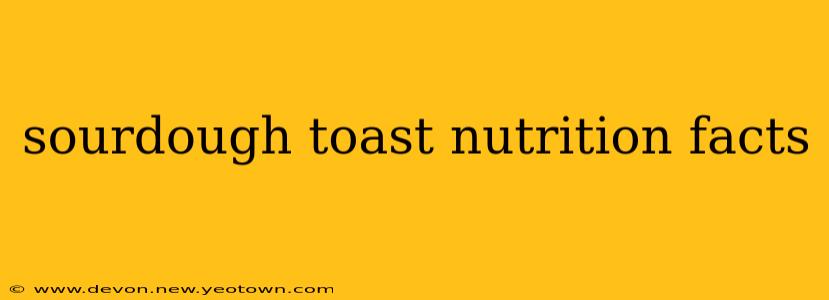Sourdough bread, with its tangy flavor and chewy texture, has become a breakfast staple for many. But beyond its deliciousness, what are the actual nutritional benefits of sourdough toast? Let's delve into the specifics and uncover the nutritional facts behind this increasingly popular food.
My name is Anya Petrova, and I'm a registered dietitian with over 10 years of experience in food science and nutrition. I've dedicated my career to helping people understand the complexities of nutrition and make informed food choices. I’ve personally experimented extensively with sourdough bread making and its dietary benefits. Today, we'll explore the nutritional profile of sourdough toast, addressing some common questions and misconceptions.
What are the nutritional benefits of sourdough bread?
Sourdough bread, unlike commercially produced breads, boasts several nutritional advantages. The fermentation process, a key component of sourdough baking, increases the bioavailability of certain nutrients, making them easier for your body to absorb. This process also reduces the amount of phytic acid, an antinutrient that can hinder mineral absorption. The result is bread that is richer in nutrients and easier to digest for many people.
Is sourdough toast healthier than other types of toast?
The answer, like many nutritional questions, is "it depends". Compared to white bread toast, sourdough often wins out. White bread is often highly processed, leading to a lower nutrient content and a higher glycemic index (GI). Sourdough, with its longer fermentation process, generally has a lower GI, meaning it causes a slower and more gradual rise in blood sugar levels. This is beneficial for individuals managing blood sugar, such as those with diabetes. However, the nutritional content of sourdough can vary depending on the ingredients used. A sourdough made with whole wheat flour will naturally have a different nutritional profile than one made with white flour.
How many calories are in a slice of sourdough toast?
The calorie count in a slice of sourdough toast can fluctuate depending on the size of the slice and the type of flour used. A typical slice (around 1 ounce or 28 grams) of sourdough made with white flour might contain approximately 70-80 calories. Whole wheat sourdough will likely contain slightly more calories due to the added fiber. It’s always best to check the nutritional information provided on the packaging of your specific brand of sourdough bread.
Does sourdough bread have less gluten?
While the fermentation process in sourdough does break down some gluten, it doesn't eliminate it entirely. Individuals with celiac disease or severe gluten intolerance should still avoid sourdough bread. However, some people with non-celiac gluten sensitivity report improved tolerance with sourdough due to the changes in gluten structure during fermentation. It's crucial to consult with a doctor or registered dietitian if you have gluten-related concerns.
What are the potential downsides of eating sourdough toast?
Despite its benefits, sourdough isn't without potential drawbacks. The high fiber content, while beneficial for digestion in many cases, can cause digestive discomfort such as bloating or gas for some individuals, especially those not accustomed to high-fiber diets. Additionally, sourdough can be higher in sodium than other breads, depending on the recipe.
Conclusion: Enjoy Sourdough in Moderation
Sourdough toast, when made with whole grains and enjoyed as part of a balanced diet, offers several nutritional advantages over other types of bread. Its lower glycemic index, potential for improved mineral absorption, and generally higher fiber content make it a worthy addition to a healthy eating plan. However, moderation is key, and it's vital to consider individual dietary needs and tolerances when incorporating sourdough into your diet. Always check the nutritional label for specific information about the bread you are consuming. Remember to consult with a healthcare professional if you have any concerns about specific dietary needs or restrictions.

